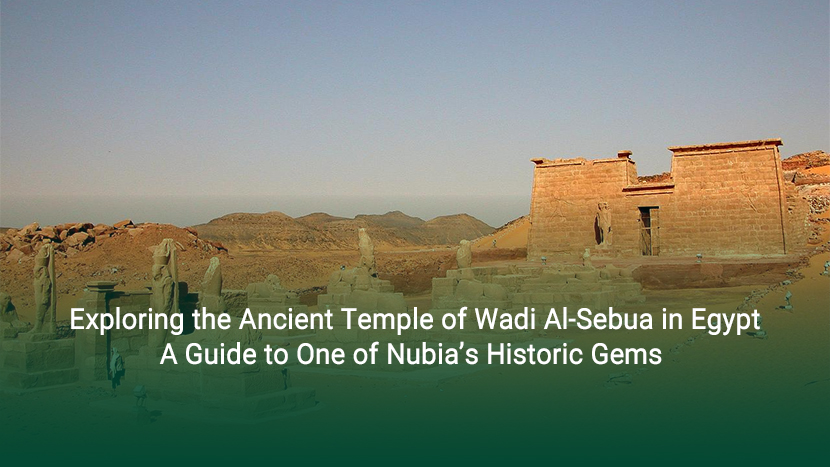
**Exploring the Ancient Temple of Wadi Al-Sebua in Egypt: A Guide to One of Nubia’s Historic Gems**
The Temple of Wadi Al-Sebua is a captivating historical monument located in Nubia, southern Egypt, near the shores of Lake Nasser. Renowned for its ancient roots and unique architectural details, this temple holds significant cultural and historical value. Built during the New Kingdom period by Pharaoh Ramses II, the temple stands as a testament to ancient Egyptian devotion and architectural innovation. It is among a collection of temples relocated to protect them from flooding caused by the Aswan High Dam’s construction in the 1960s.
### Historical Background of Wadi Al-Sebua Temple
Constructed around the 13th century BCE, the Temple of Wadi Al-Sebua, meaning “Valley of the Lions,” earned its name from the prominent sphinx statues that line the entrance. Ramses II dedicated this temple to the gods Amun and Ra-Horakhty, honoring the powerful deities associated with the sun. The temple's impressive structure, blending both traditional Egyptian and Nubian architectural styles, highlights the Pharaoh’s commitment to asserting Egyptian influence in Nubia, a region historically tied to the Egyptian empire.
### Architectural Features of Wadi Al-Sebua Temple
The temple's architecture reveals the influence of both Egyptian religious traditions and local Nubian styles. Visitors are greeted by two rows of imposing sphinx statues, each carved with striking detail. The pathway leads to a large pylon, adorned with inscriptions and carvings celebrating Ramses II’s achievements and victories. The temple includes a central courtyard and various chambers that were once used for worship and ceremonial purposes.
Inside the temple, there are well-preserved reliefs and carvings depicting Ramses II and religious symbols associated with Amun and Ra. The temple's sanctuary houses several statues of the pharaoh and deities, providing a glimpse into the spiritual life of ancient Egypt.
### The Relocation of Wadi Al-Sebua Temple
In the 1960s, the construction of the Aswan High Dam threatened to submerge many Nubian temples, including Wadi Al-Sebua. UNESCO led a massive relocation project to save these ancient treasures. The Temple of Wadi Al-Sebua was carefully dismantled and moved to its current location, 4 kilometers away from its original site. This relocation not only preserved the temple but also ensured future generations would have the opportunity to experience Nubian history firsthand.
### Visiting Wadi Al-Sebua Today
Located near Lake Nasser, Wadi Al-Sebua is accessible via Nile cruises or by road from Aswan. The serene surroundings of Lake Nasser enhance the temple's mystique, making it a unique destination for history enthusiasts and travelers alike. Visitors can explore the temple grounds, learn about ancient Egyptian religion, and enjoy the tranquil desert landscape.
### Importance of Wadi Al-Sebua Temple in Egyptian History
The Temple of Wadi Al-Sebua is not just an architectural marvel; it represents Ramses II's political and religious ambitions. By building monumental temples in Nubia, he reinforced Egypt’s presence in the region, fostering cultural and religious connections. Today, Wadi Al-Sebua stands as a symbol of Ramses II’s legacy and Egypt's enduring cultural heritage.
### Conclusion
The Temple of Wadi Al-Sebua in Egypt is a historical gem offering insight into the cultural and religious dynamics of ancient Egypt and Nubia. Its impressive architecture, symbolic sphinx-lined pathway, and enduring legacy make it a must-visit destination for anyone interested in Egypt's rich past. For travelers and history enthusiasts, exploring Wadi Al-Sebua provides a unique glimpse into the grandeur of ancient Egypt and its far-reaching influence across regions.
Traveling to historical cities is very rewarding and gives you the opportunity to discover the secrets of the past. Lower Nubia and other ancient cities are areas full of historical wonders that will be attractive and exciting for any tourist. So be sure to put this region of Egypt on your list of virtual tourism destinations (live and direct broadcast) and travel there with a relaxed mind and riding the waves.If you have personally traveled to this Historical monument, please write your experiences and memories for us and other readers so that they can use these experiences to plan a dreamy and memorable trip.
By using form u agree with the message sorage, you can contact us directly now